Stop winging it and start following a roadmap that’s customized for your business with your products, goals, and audience in mind.
Introduction: The What and Why of Marketing Strategies
A substantial part of all marketing is now digital. Gone are the days when we relied on Yellow Pages, billboards, and radio ads to spread the word about our business. Now, we can take to the digital airwaves to reach a wider (yet more specific) audience and evolve beyond our local markets.
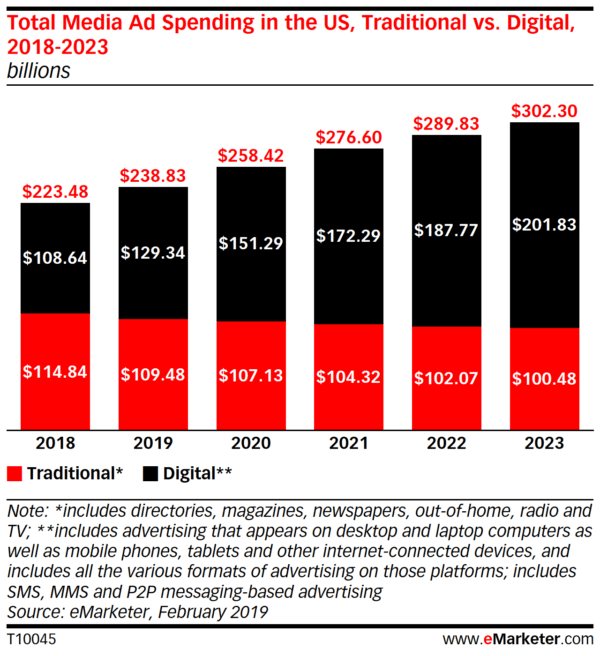
Even so, the shift to digital doesn’t excuse you from having a strategy, just like in the good old days. Technology and trends are moving faster than ever, and a digital marketing strategy can help you keep up and stay aligned with your goals and audience.
By definition, a digital marketing strategy is simply a plan for achieving a specific goal. Having this strategy spelled out gives you something to focus on and makes each activity related to your goal more achievable than if you left everything to chance.
To be clear, a digital marketing strategy is not the same as marketing tactics. I hear a lot of entrepreneurs using the two interchangeably, but the difference is this:
Your marketing strategy is the destination, while tactics are the actions you take to reach the destination.
In this guide, I’m going to show you step by step how to develop a digital marketing strategy that works for your business. There are a lot of moving parts to a marketing strategy, especially when you’re creating one from scratch. And even though I wouldn’t exactly call it a simple process, my goal is to make it simpler by breaking it down into smaller, digestible pieces that you can tackle one at a time.
Let’s get started:
Chapter 1: Defining Marketing’s Role
For many entrepreneurs and small businesses, marketing is the life source of revenue. It’s the main driver of branding and sales, and without it, many businesses wouldn’t be able to survive.
But I also want to mention that a marketing strategy isn’t the same as a business strategy. These are two very distinct functions, but they support each other and should ultimately align with each other for the best results.
What is Business Strategy?
Before you can go about developing your marketing strategy, you first need to define your business strategy. This is the broad term for your organization’s mission, vision, values, and priorities.
Michael Porter talks about three generic strategies that can be applied to any type of business. They are cost leadership, differentiation, and focus. Today, most businesses assume one of these four fundamental strategies:
- Cost leadership (promotes value pricing to get larger volumes of sales)
- Pioneer (creates new products and markets)
- Fast Following (bridges the gap between early adopter and early majority)
- Customer-Centric (owns the customer experience)
In some cases, you may have elements of more than one business strategy in mind. You should choose one to be your main driver so that you can align your marketing to support that strategy.
How Marketing Should Support the Business Strategy
When you’re choosing marketing activities to increase awareness and generate sales, it’s important to consider your business strategy first, then choose the various elements that support your business strategy.
For example, if you want to be seen as a fast follower that improves on existing products, then your marketing should highlight what makes you better than the original. You might explore new markets that haven’t been penetrated by the original product or find new ways of getting your product in front of an audience.
All of these elements work together in a well-developed marketing strategy. When one or more of these elements is missing, you risk missing out on valuable opportunities to strengthen your marketing and company as a whole.
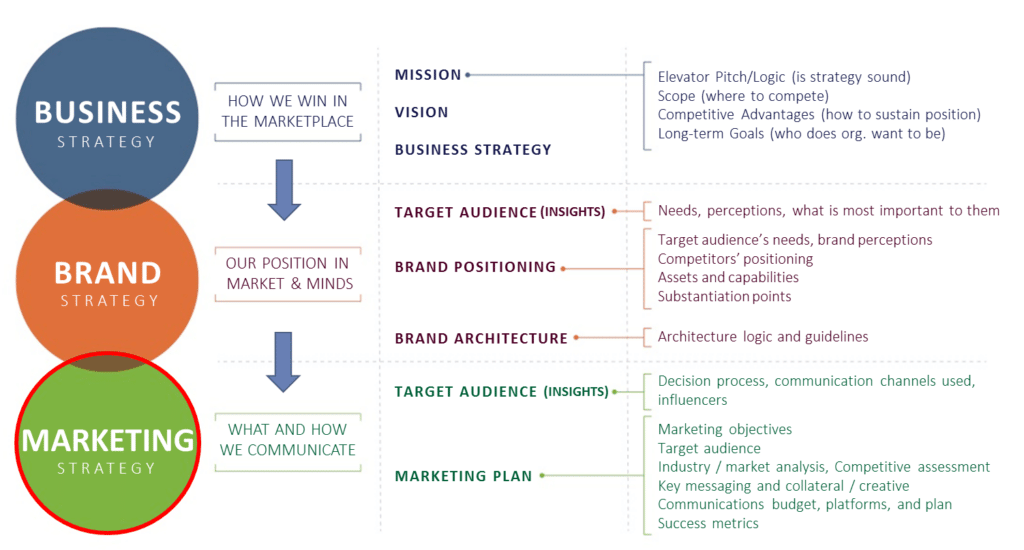
For example, what would you think if your local dollar store started selling high-end designer brands (at high-end designer prices)? I know how I’d feel: I would question the quality and veracity of the products (are they knock-offs?) and I’d feel really confused about why they chose to mix high-end fashion with dollar plates and cups. Plus, they risk alienating their existing customer base that may not be able to afford high-end fashion.
Those two things just don’t go together. Sure, it might net the dollar store a few more sales and bring in a new segment of customers — maybe. But more than likely, it’s going to lead to brand confusion, plus it does nothing to promote the store’s reputation as a value leader.
To Summarize
Marketing and business strategies should work together to create the desired end result. It starts with a business strategy, with marketing playing a supporting role. When the two aren’t aligned, it can lead to a lack of cohesion and clarity with the brand and create missed opportunities to grow your business.
Chapter 2: Understanding Business Objectives
There’s a lot that marketing can accomplish. Some people leverage marketing to generate leads and sales. Others do it for brand recognition, audience growth, building authority, or a number of other objectives. Some even want all of the above, and that’s okay, too.
Whatever your unique goals are, it’s important that you establish them FIRST. This is essential for aligning your marketing tactics with your other business initiatives.
What Makes Your Business Tick?
Your business is comprised of several components that make it unique:
- Your company mission
- The company’s long-term vision
- The brand
- Channels of customer acquisition
- Value propositions
- Target audience(s)
- The market in which you’re competing
- Customer retention methods
- Pricing strategies
Your digital marketing strategy should support each of the above components if you expect your efforts to pay off.
Prioritizing Your Objectives
I like to think of aligning business objectives like car shopping: there are LOTS of cars for sale at a dealership, and you could spend a good chunk of your time test driving one after another. But if you go to the dealership armed with a list of things you need or want in a car, you can narrow down your options and find a car that will fit your needs much faster.
The same holds true with marketing: there are a LOT of things you can do to market your business. But that doesn’t mean that all of your options are going to support your key business objectives and marketing goals. Rather, when you have a list of objectives you want to accomplish and can focus on the end results, you’ll have a much easier time prioritizing the right activities that will net you those results.
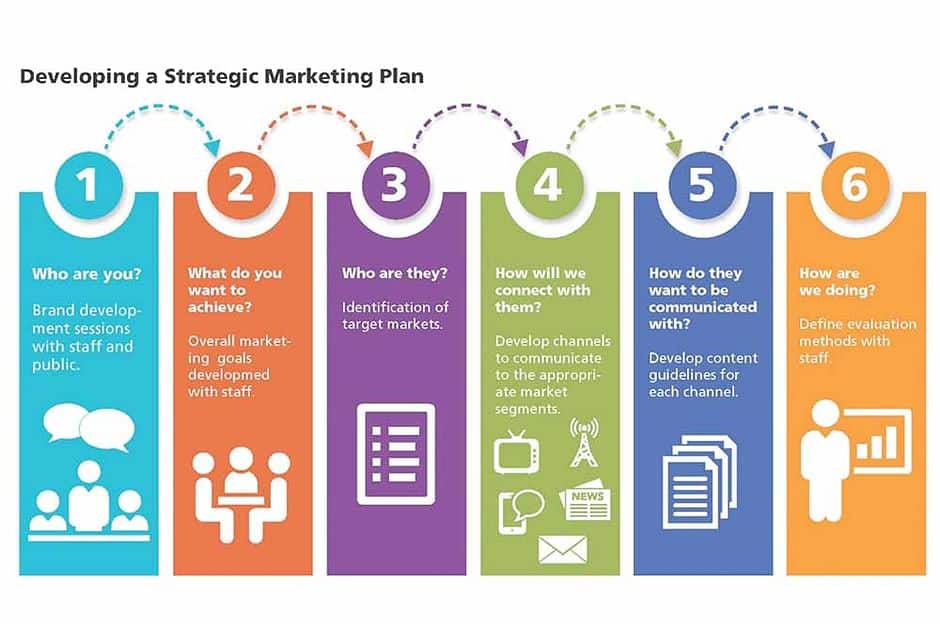
When we’re talking about aligning business objectives, it’s helpful to think of your overall goals and then work backward from there.
For example, let’s say you want your solopreneur venture to make $500K this year. You could break that goal down into monthly or weekly goals, then consider what steps you need to do to reach those financial goals. When choosing marketing tactics to earn customers and revenue, you’ll also want to consider how those goals fit into your branding, company mission and vision, and all of the other components I listed above.
Now, let’s say you choose to host a webinar with the goal of generating $25,000. The webinar (and all of the marketing you do to promote the webinar) should
- Reflect your company’s mission, values, and branding
- Be tailored to your target audience
- Be priced in a way that makes sense for your target audience
- Be promoted via the right channels
- Have something to do with the market you’re in
In other words, it’s not enough to create a webinar and stick your name and logo on it. You’ll see much better results when you’re supporting all of the elements that make up your business and that your audience is already familiar with.
To Summarize
Before you start building a marketing strategy, you first need to understand why you’re marketing, the goals you want to accomplish, and how your marketing will support and align with the rest of your business. This is not a one size fits all exercise, so look deeply at your current business landscape to identify the right opportunities.
Chapter 3: Conducting a SWOT Analysis
A SWOT analysis is a popular, powerful tool to help guide your marketing strategy. A lot of entrepreneurs and startups will use a SWOT analysis to determine their business’s viability in the marketplace before launching. But it’s also helpful when you’re putting together a new marketing strategy or tweaking your existing strategy because it reveals Strengths, Weaknesses, Opportunities, and Threats (which is exactly what SWOT stands for).
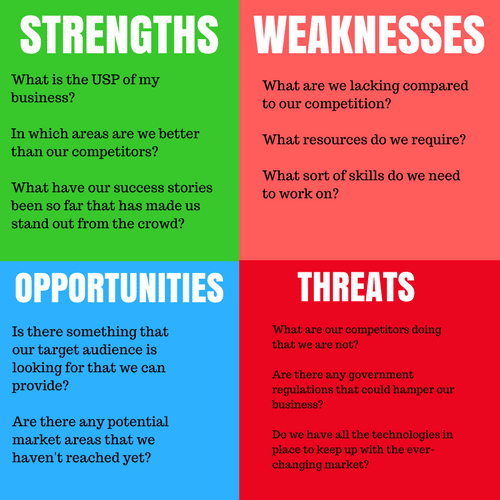
Your Strengths and Weaknesses are internal factors and are pretty self-explanatory. They’re what you’re doing well and what you can improve, respectively. And since they’re internal, you have control over these factors.
Your Opportunities and Threats are external factors. They represent new opportunities for growth or improvement, such as new customer segments to tap into, and factors that could threaten your business’s profitability or viability in the market, such as new competition. You have less control over these factors, but knowing more about both can help you tailor your response.
Here are a few other examples of SWOT factors:
Strengths
- Things your company does well
- Proprietary technology or products
- Internal resources, such as skilled employees
- Positive reputation
- Large market share
- Anything that can be considered a competitive advantage
Weaknesses
- Anything a competitor does better
- Limited resources
- Undefined unique selling proposition
- Things your company lacks
Opportunities
- New customer interests
- Underserved markets
- A strong economy
- Competitors going out of business
- New supply lines
- Positive press or media for your company
Threats
- An increase in the price of raw materials or vendor services you use
- Customer shopping patterns
- Economic downturn
- Competitors entering the market
- Changes in regulations
- Negative press, media coverage, or online reviews
How Does SWOT Relate to Marketing?
SWOT analyses are perfect for prioritizing your marketing activities. Even if you already have a good idea as to what you want to accomplish and how you’re going to do it, conducting a SWOT analysis forces you to look at your business in different ways. It sends your brain into different directions that you may not have previously considered, and you may even find new objectives you want to pursue that could yield a larger payout.
If you have a team, it’s helpful to get buy-in from different people when doing a SWOT analysis. Two heads are better than one, after all. However, if you choose to get others’ opinions, I recommend having each person conduct their own SWOT analysis first and then share their ideas with the group. This can prevent the dreaded “groupthink” that can stifle new ideas from forming.
Of course, if you’re a solopreneur, nobody knows your business better than you. You can still do a successful SWOT analysis on your own. Let your ideas simmer for a few days, then revisit your analysis to see if anything new has come up. From there, you can begin to prioritize your marketing activities based on the results of your SWOT analysis.
Questions to Inform Your SWOT Analysis
As you’re going through the SWOT analysis, you want to make sure you’re asking valuable questions that will drive honest responses and uncover helpful information. Let’s look at some questions you can ask through the analysis:
Strengths
- What is the business doing well that makes it successful?
- Where do our profits come from?
- Where are our best referral sources and marketing channels?
- What assets do we have among our team, such as skills, knowledge, and experience?
- What are our competitive advantages and Unique Selling Propositions?
Weaknesses
- What processes need improvement?
- Are there gaps in our knowledge, skill sets, or team?
- Are we in an ideal location that maximizes visibility and minimizes operating costs?
- Are we lacking tangible assets, such as technology or equipment?
- What are our competitors doing better than we are?
Opportunities
- Is the market growing or are there other factors that will encourage people to buy more of what we sell?
- Are there any upcoming events that we can take advantage of to make more sales?
- Do our customers love us and recommend us to others?
Threats
- Have new competitors entered the market?
- What market trends are negatively impacting our business?
- Are consumer behaviors shifting away from our products?
- Can we continue to get the same raw materials or supplies at the same price to continue serving our customers?
- Will any changes in regulations affect how we do business?
Using SWOT Analysis Data to Drive Your Digital Marketing Strategy
After you finish your SWOT analysis, I recommend choosing no more than three factors for each group. This way, you’re not stretching your resources so thin that you’ll struggle to dramatically influence any of them.
Drill down on three out of each group that you stand to make the greatest impact with your marketing.
Let’s use this SWOT analysis as an example exercise:
Company Name: ABC Marketing
Strengths:
- High customer retention rate
- High click-through rate on digital ads
- Very low overhead
Weaknesses:
- Not much organic website traffic
- Can’t publish new content as fast as competitors
Opportunities:
- Not many local marketing agencies
- Not much high-level content aimed at marketing managers to develop strategies
Threats:
- Relatively low bar to entry to offer some marketing services
- Competition has greater domain authority and organic traffic
We could probably add a few things to each of these, but let’s roll with these for now.
Using this SWOT analysis for our fictitious marketing company, we can see that the strengths may hold some answers when creating their marketing strategy.
For example, low overhead could mean they have extra funds to put toward fixing some of their weaknesses. High customer retention rates could reflect that whatever they’re doing to keep customers is working, so they may want to focus more on new customer acquisition.
As for weaknesses, they might choose to outsource content creation so they can keep up with their competitors. Sites like Fiverr and FlexJobs help to connect you with high-quality freelancers at reasonable prices. If funds allow, they might also choose to leverage an SEO tool like SEMRush that can help them grow their organic website traffic.
Since there aren’t many local agencies, they may want to focus on catering to a local audience. Hosting local events and investing in local SEO might be part of this strategy.
Last but not least, threats can’t be fully eliminated, but they can be mitigated. One strategy might be to grow such a large local presence that prevents others from entering the market. Or, they might focus their efforts on building domain authority by improving organic traffic and content creation.
To Summarize
A SWOT analysis is an excellent building block for your digital marketing strategy because it forces you to think outside of what’s already on your radar. They’re fairly simple to complete and can inform your priorities to help you optimize your time and resources.
Chapter 4: Creating a Competitor Profile
Competitors are like opinions — everybody’s got one. You might be lucky enough to have found a small niche area that flies under the radar and keeps your coffers full. Or, you might find yourself surrounded by lookalike businesses that make it difficult to claim a huge market share.
Whatever your situation, you’ll want to do a competitor analysis to help inform your marketing strategy.
Why?
For starters, knowing what your competitors are doing, for better or for worse, can help you spot gaps or opportunities in their strategy. This paves a clear path for you to do something better than what they’re doing, and ideally win more business as a result.
Also, you deserve to know how your competition works, what they’re offering, and how they’re earning customers. Because those customers could also be your customers! You might be able to beat them at their own game, or you may choose to take a different (and better) route altogether.
The ultimate goal is to understand how your competitors might be winning more business than you, and then using that information to perfect your own marketing and business strategies.
And no, a competitor analysis is NOT scoping out their website and social media accounts. That might be part of it, but if you stop there, you’re missing out on essential, critical knowledge that could help you grow your business.
What Goes into a Competitor Analysis?
There are several steps involved if you want to do a thorough competitor analysis.
Know Your Competitors
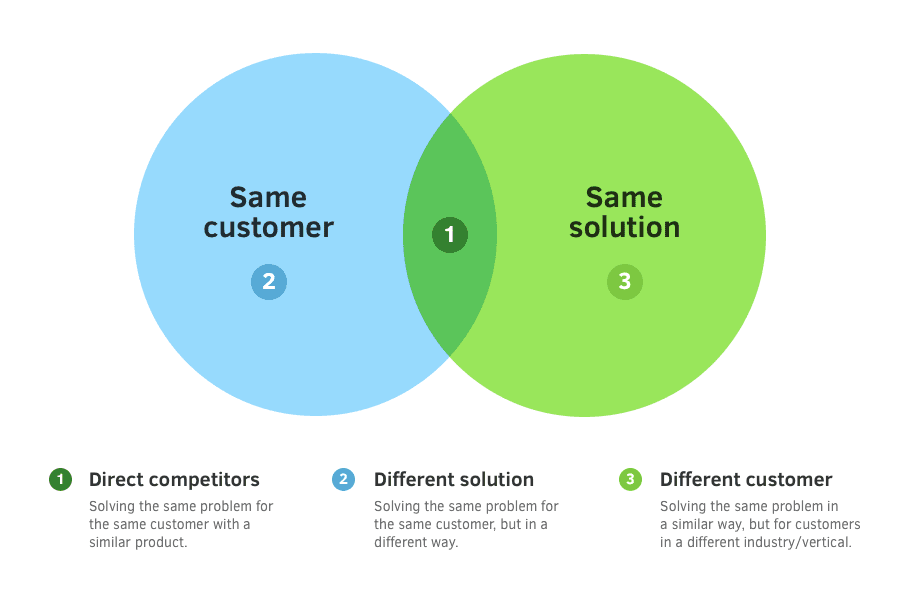
The first, of course, is understanding who your competitors are. Someone can be considered a competitor if they
● Sell similar products or services as you to the same target market – this is a direct competitor
● Sell different products or services that can satisfy the same need or problem – this is an indirect competitor
For marketing strategy purposes, you should really only focus on your direct competitors.
However, it’s a good idea to keep your indirect competitors on your radar in case they decide to shift their strategy into your territory.
Review Their Products and Services
Once you identify your direct competitors, take a closer look at the services they offer. Look for things like quality, price, quantities, distribution channels, and any other detail you can compare to your own sales methods. Pay attention to the items you both offer, as well as products they offer that you don’t (and vice versa).
Understand Their Sales Process
If you pay close enough attention, you can usually reverse engineer their sales process by clicking through their website and other channels. Knowing how they convert visitors into customers may help you identify missed opportunities in your own sales strategy.
Ultimately, your investigation should try to answer the following questions:
- What channel(s) do they sell through?
- Do they have more than one location, and if so, how does this give them an advantage?
- Do they use affiliates or partner resellers?
- How do they discount their services?
- What incentives do they offer to get people to buy?
- How involved is a salesperson in the buying process?
Find Out How Competitors are Marketing Themselves
Sometimes, it’s clear that your competitors are marketing themselves. You see their ads all over town or can’t seem to clear their retargeted ads from your web browser. But since there are so many ways to market a business, you’ll want to understand as much as possible about how they’re growing their digital presence.
The best place to start is to head to their Facebook page and see if they’re running ads. You can do this by clicking on the Page Transparency link, then clicking the “Go to Ad Library” button. You’ll be able to see their previous ads as well as any campaigns they’re currently running. Look at their graphics, copy, calls to action, and links that direct to their landing pages.
You can also scope out their website to see if they have an email newsletter. If so, consider signing up for it so you can keep tabs on their outreach.
SEMRush has a great backlink audit tool that can generate a free report on your competitor’s backlinks. Knowing this may help you identify potential referral sources or guest blogging opportunities for yourself. Follow this link to get your own free report today.
Another place to check is LinkedIn, where they might be publishing blogs or thought leadership pieces. Look at how often they post on social media, as well as the types of content they create or share. When they post content, look at their engagement rates (e.g. likes, shares, comments) to see how people are responding.
Some other items to check include:
- A blog on their website
- Guest blog posts on other websites
- White papers or slide decks
- A podcast
- Press releases
- Media kits
- Case studies
- Buying guides and sales sheets
- Videos and/or webinars
In addition to the types of content marketing, you should also pay attention to the content itself. For example, if you notice they’ve put out a lot of similar content, it might be because those are highly effective for them.
Do a SWOT Analysis for Your Competitors
Last but not least, you can use the steps we covered on conducting a SWOT analysis for your competitors. As a third-party observer, it’s fairly easy to spot what someone is doing well and where they’re dropping the ball. This also gives you an apples-to-apples comparison when vetting your own SWOT analysis.
To Summarize
Conducting a competitor analysis is one of the most valuable steps in developing your own marketing strategy. You need to see how your business stacks up against someone else’s so you can continue to try harder and be better at what you do. The key is to remain objective throughout the process — even though you may think you have a competitive edge, it pays to be honest about how your competitors might be better so you can tailor your own strategy and come out on top.
Chapter 5: Reviewing Market Trends
Keeping up with current market trends is an ongoing job. People change, products change, budgets change — eventually, you may need to pivot your services and marketing efforts to continue catering to your customers’ expectations.
A powerful example of this is the COVID-19 pandemic. It turned everything on its head. Many entrepreneurs were at a loss as to how they could continue providing value to their customers, even those who were no longer buying as a direct result of the pandemic. Others were able to shift their product offerings accordingly, like Anheuser-Busch did when they switched to making hand sanitizer to fill a growing void.
Sometimes, you will have very little warning when it comes to adapting to changing markets. Other times, change happens so gradually that you may not realize when you’re no longer meeting your customers’ needs.
This is exactly why you should make it a practice to review market trends on a regular basis and adjust your marketing strategy accordingly. Here are some ways you can keep your finger on the pulse of your industry:
Join a Trade Association
Most industries have professional organizations you can join for an annual fee. Some will offer trial memberships, while others may offer different tiers that you can choose based on your budget. These organizations are a great way to stay in the know about what’s happening in your industry. Most of them will hold annual meetings or conferences for networking and professional development, which gives you additional opportunities to make connections and learn where your industry is heading.
Read Industry Publications
Do a Google search to find professional research or publications related to your industry. You may be able to sign up with these providers to receive the latest news in your email inbox. There’s also a chance your competitors may hire research firms to conduct studies on their behalf, which they make available for their readers. Look for competitors that publish these types of pieces so you can capitalize on their research for yourself.
Attend Professional Development Conferences
You can usually find multiple conferences for specific industries in any given calendar year. Go to Google or ask colleagues in your field for references. These conferences often cover topics that you can use to improve your skills, as well as “look ahead” segments that predict what the industry will do next and how you can get ahead.
Follow the Experts
Experts don’t just talk about what’s happening right now, but also share their predictions as to what the market might be like in the future. Find the experts in your industry or niche and start following them on social media. Listen to their podcasts and read their blogs. At the very least, you might learn something valuable you didn’t know before.
Look for Trends in Your Own Data
Don’t forget about the mountain of your own data you’re likely sitting on and doing nothing with. From CRM to sales trends to financial reports, you can learn a lot about how your business is trending simply by reviewing your own data stores. Are sales increasing or decreasing? What about expenses? Number of customers? Customer lifetime values? It’s easier to ask the questions first, then go find the answers.
To Summarize
Market trends are constantly changing, and you’d do well to change alongside them. It’s important to take a proactive approach to adjusting your business, rather than a reactive one when it might be too late. Keeping your finger on the pulse of your industry, including competitors, new products, and technology’s influence, can help you make informed decisions at the right time.
Chapter 6: Narrowing Your Personas

A lot of marketers make the mistake of jumping straight into customer personas when developing a digital marketing strategy. That’s not exactly the wrong thing to do, but I believe you need to lay the other groundwork first before you can decide who exactly you’re marketing to. This means understanding your own company’s status, fleshing out your competitor’s profile, and reviewing market trends BEFORE you decide who you want to buy from you.
This process includes understanding your buyer’s underlying pain points and what motivates them to buy. What characteristics do they have in common? What do they need from you? Can they afford to buy from you? What will pique their interest? Where do they hang out online?
Like everything else we’ve covered up until this point, creating your buyer personas is a multi-step process. Not only do you need specific personas that represent your ideal customer, but you also need to understand the size of your total addressable market, your current market penetration, and your goal market penetration.
Here’s how you can get started:
Creating the Ideal Buyer Persona
In the past, marketers were obsessed with collecting qualitative and quantitative data that represented their ideal buyer. To an extent, this type of data is still helpful, but developing a persona takes your buyer profile several layers deeper.
To be clear, a buyer persona is a detailed description of what your average buyer looks like.
For example, if your target audience is young moms ages 20-34, then your buyer persona might look something like this:
“Young supermom Ashley, age 29, who is working a full-time job outside the home, has at least one child under the age of five and is living on a budget in a middle-class neighborhood. She wants to be more present for her kids so they can spend quality time together, enjoy healthy meals instead of the drive-through, and create more memories. She’s the mom who never misses an event or birthday, but stays up late most nights to catch up on housework or other duties.”
See how the buyer persona gives us so much more detail about the moms you want to buy from you?
Creating this type of buyer persona requires you to dive deeper into your customers’ lives, understand their pain points and motivations for making a change, and recognizing potential barriers that could prevent them from acting on your offer.
In this case, Ashley’s motivations would likely be the prospect of spending more time with her kids and enjoying a healthier lifestyle. She wants more time freedom, and would perhaps consider a career change if it meant more money, time, or flexibility. However, since she’s living on a budget, money could be an obstacle that stops her from buying.
One thing I want to mention here is that buyer personas often fall into stereotypes. This is not helpful for you or your business, so make sure you’re basing your personas off of real research and not guesses.
Facebook Audience Insights is an excellent place to start learning about audience segments. You can filter audiences by purchasing behavior, household demographics, income, location, user activity, and more. Xtensio offers a free Buyer Persona template that you can use to develop your ideal buyer profiles.
Use Your Buyer Personas to Gauge Market Size
Now that you know who you’re selling to, are there enough of those types of people that will buy from you? This is referred to as market size, and it’s super important to consider when developing your marketing strategy.
It’s a safe bet that not every person that fits your ideal buyer is going to buy from you. Even with a great product and marketing, you may only capture 10% of the market. That’s okay, if the market is large enough.
For example, if you’re catering to small digital marketing agencies with under 50 employees in the state of Florida, then you could find out how many marketing agencies fit the bill. That’s your market size.
Market size is important in developing a digital marketing strategy because it helps you see if there are enough customers to serve that will make your efforts worthwhile. Choosing niche markets isn’t a bad thing if you can earn a high penetration (more on this in the next section). But some markets are just too small to be profitable, so you need to think about whether there are enough customers to split between you and your competitors. If not, you may end up out of business.
Calculate Your Current Market Penetration
Penetration rate is the percentage of your target market that has purchased your product or service. For example, a computer manufacturer may have a high penetration rate because it’s just about impossible to run a business without one, whereas a highly specialized gadget may have a low penetration rate because not as many people need or want it.
You can calculate penetration rate by dividing the number of customers you’ve acquired by the total market size. Using our Florida marketing agency example, if there are 10,000 agencies in Florida and you serve 100 of them, then your penetration rate is 1%.
A low penetration rate indicates there’s a lot of room for growth within your niche or vertical. When related to marketing strategies, you may want to consider expanding your marketing to increase penetration within the same industry.
A high penetration rate, however, could mean that you might be maxed out in a particular market. You may never achieve 100%, but the higher your penetration rate, the more you should consider expanding into a new market or vertical.
Chapter 7: Developing Your Position and Messaging
There’s an old saying in business: “When two companies are exactly alike, one isn’t necessary.”
There is a LOT of competition out there for just about every industry. And while many companies may look alike on the surface, you could probably find several key differences that make them unique enough to stay in the market.
Let’s take Walmart vs. Target: they’re both big box mass merchandise stores. Both offer convenience with curbside pickup services. Both offer a range of items and cater to a lot of the same customers. But both are able to thrive because the retail market is so huge, they don’t carry all of the same brands, and most notably, they have very different messaging and positioning priorities.
Walmart will always be seen as the low price leader, while Target is more focused on the in-store experience. Walmart stores are huge and impersonal, while Target stores are warm and friendly.
We could pick this apart all day and find countless unique details, but what I want you to take away from this is that how you position your company will have a lot to do with how you market yourself, and to whom you’re marketing.
The Four P’s of Marketing
The “Four P’s of Marketing” is a popular concept that forms the basis of any marketing strategy. They are:
- Price (product price, discounts, credit policy)
- Placement (market, channel, distribution methods)
- Product (brand, services, packaging)
- Promotion (advertising, publicity, sales promotions)
And according to Neil Patel, the smaller your company, the more important the four P’s become.
Your Products are what you make available to your buyers. These could be tangible goods, or they could be services or software you offer. Your job in developing a marketing strategy is to understand what makes your products unique from your competitors and why your customers should buy them.
Your Price is how much your customers will pay for the products. Coming up with the right price is challenging: pricing it too low could indicate lower quality. Pricing it too high limits how much of the market you’ll capture. Pricing it alongside your competitors could eliminate a potential competitive advantage. To strike the right balance, go back to your buyer personas to see what they’re paying for similar products and what’s in their budget. If they respond well to sales and discounts, you could always price your product higher so you can offer special promotions.
Place is all about location. Choosing the right channels based on your target audience is the key to maximizing your visibility. You have to go to them vs. waiting for them to come to you (this isn’t Field of Dreams, you know).
Last but not least, let’s talk Promotion. This is what most people think of when it comes to marketing since promotion is an obvious catalyst for revenue. Promotion ties in your brand, messaging, and the other three P’s. It also requires you to consider the timing of your promotions. For example, many retailers double down on sales and promotions during the holidays because they know people are shopping for bargains. Likewise, a lot of people are hesitant to spend money in January (there’s even a popular No-Spend January challenge that circulates on the Internet each year), so many companies have started offering promotions during this time to drum up business.
Together, the four P’s can help you position your marketing to the right people at the right place at the right time, and for the right price.
How to Craft Your Marketing Messaging
Effective marketing messages aren’t just creative or gimmicky. The most effective ones are those that can catch immediate attention, relate to your product, and support your brand — all at once.
Ultimately, your marketing is about your customers, not about you. Your messaging should reflect what’s important to them. In most cases, people are intrigued by things that will answer their burning questions, teach them something, help them solve problems, take advantage of convenience, or live a better quality of life. These are the things your messaging should reflect. Headlines that make the reader feel like you’re speaking directly to them and understand their needs are so much more effective than generic one-size-fits-all messages.
Here are some great headlines I’ve come across over the last few weeks that do an excellent job of arousing interest:
“73 Types of Blog Posts That Are Proven to Work”
I love this one because I know upfront that it’s going to give me a wealth of ideas, plus I know these ideas have been vetted and proven by industry professionals. There’s a huge trust factor built into this headline that makes it more compelling.
“Where to Find Free Images Online”
This is a common question in my industry, and one that many creative professionals need answered. Also, it caters directly to creatives like myself.
“Why James Chartrand Wears Women’s Underpants”
This one is attention-grabbing, even though I care nothing about the subject. It’s fun and quirky, and to the right reader, it could shed some important insight.
“21 Settings, Techniques, and Rules All New Camera Owners Should Know”
I like how this one is targeted specifically to new camera owners, so I know it’s probably 101-level content. It also does a good job of setting the right expectations for what I’m about to read.
To Summarize
How you position your marketing will have a lot to do with how it gets noticed by your target audience. You want to craft your messaging and the four P’s around your audience’s needs and wants, make your messaging about them (not you!), and set the right expectations from the start. Your messaging and positioning should be different enough to set you apart from your competitors and well-branded so that people can associate your messaging with your company.
Chapter 8: Creating Your Digital Marketing Mix
We’re officially at my favorite part of creating a digital marketing strategy — choosing what to include in your marketing mix. Your marketing mix is the collection of all the types of content and channels you use to market yourself online.
We’re going to go through some of the most popular types of digital marketing activities, but first, I want to stress the old Chinese proverb that he who chases two rabbits goes home hungry.
This is almost always true in digital marketing: if you focus on trying to do all the things, you end up not doing any of the things particularly well. Big companies can be everywhere and do all the things because they have enough people and resources to make their efforts successful.
But as a solopreneur, you need to pick a couple of options and go deep with them. You’ll see much greater success when you focus your efforts on the few things that work well for you and that you can become an expert at.
So, how do you choose the right digital marketing mix ingredients to craft your perfect, sales-filled recipe?
I recommend starting with your customers. Do they watch online webinars, read blog posts, or click on ads? Do they check email often and purchase things recommended to them? Are they searching for products like yours via search engines? Do they use Facebook or Instagram?
*Hint: this is why we did the buyer persona early on in this exercise. If you didn’t discover the answers to the above questions, now is a good time to go back and see if you can find out more about your ideal customers.
Now, let’s jump into the different types of digital marketing media you can use to increase brand awareness, provide value, and generate revenue:
Paid ads
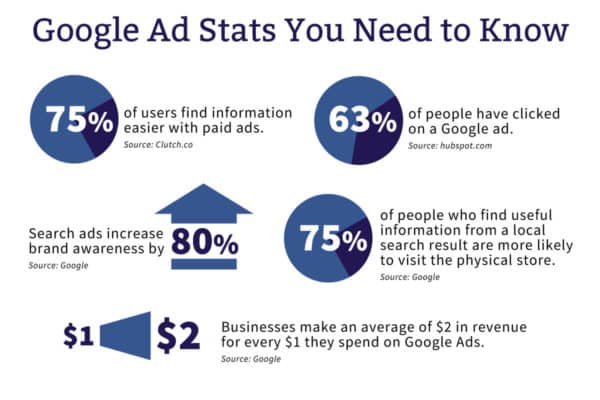
Paid ads can take several formats: social media advertising, search engine marketing, and retargeting, to name a few. In most cases, you will only pay for ads when someone clicks on it, which can make this type of marketing more of a “safe bet” in that people who click are likely interested in what you’re offering.
In other cases, you’ll pay per impression. This means that the advertising platform will charge you a small fee each time your ad is shown to a potential customer, regardless of whether they take action.
One of the advantages of paid ads is that you can influence the cost. Unlike print ads or traditional media, you can tailor your ad spend to your budget. You can also dial in on specific audience segments to ensure your ads are shown to people who are more likely to buy from you.
For example, with Facebook Ads you can narrow your audience based on unique demographics and buying behaviors. With Google Ads, you can optimize your ad to show up in relevant search results. People who are actively searching for what you offer will be the ones to see your ads, plus your ads will likely be at the top of the page BEFORE the organic results.
Video
Video has been pegged as THE format for digital marketing now and in the coming years. A report by Oberlo shows that 85% of people watch online videos, while 54% of consumers say they want to see more videos from brands.
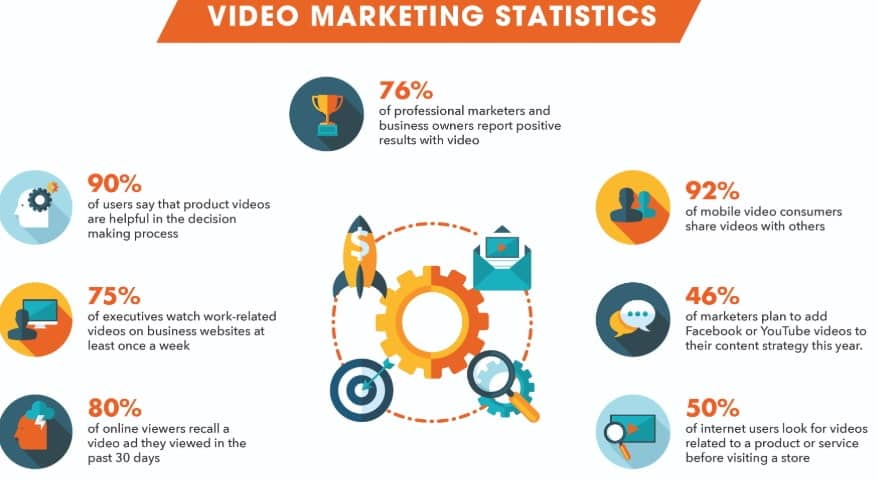
Video marketing can take several approaches, from highlighting a product to explaining a concept. You can also use videos and live video features to go behind the scenes at events, share stories or interviews, and even showcase customer testimonials.
If you’re a solopreneur, don’t shy away from video because you think it’s too expensive or complicated. Outsourcing your video marketing may be more affordable than you think, especially if you use video professionals on Fiverr. What’s great about Fiverr is that they guarantee the work of their freelancers, so they don’t get paid until you are satisfied. Check out their many options here.
You can also use Facebook Live or TikTok to record your own videos, even if they don’t have a “professional” look. In fact, many users love the raw effects of homemade videos and find them to be more honest and engaging. You can use this type of video to create deeper connections with your audience, keep them up to date on what you’re doing, and share the human side of your brand.
Social Media
Social media marketing could easily be its own chapter, given the variety of platforms you could leverage. Many brands use social media to build relationships and stay in touch and top of mind with their audience. But you can also use it to drive website traffic, generate sales, and highlight your products and services.
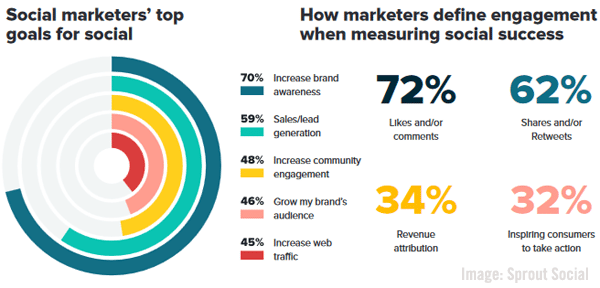
It’s a common mistake to try to use all of the social media platforms to market your business, but in this case, the Less is More mentality rings truer than ever. As a small business or solopreneur, you need to focus your resources to your strengths.
Let’s look at some of your options and why you might choose them for your digital marketing mix:
- Just about everyone is on Facebook, with more than 2 billion daily active users
- Lots of visibility, but also lots of competition
- Opportunities for paid ads
- Ability to directly respond to users
- Online reviews
- Quick microblogs for one-off thoughts
- Real-time updates
- Social media platform of choice for people seeking news and current events
- High level of engagement
- Heavy on visual elements
- Ability to connect with other brands and users
- Perfect for building brand partnerships
- Caters to a mostly younger crowd (Gen Z and Millennials)
- Ideal for inspirational content
- People use Pinterest with a buyer’s or learner’s mindset
- Content ages well and can be recirculated for years
TikTok
- Caters to a mostly younger crowd
- Engaging, instant, and fun
- Shows the human side of a brand
YouTube
- Second largest search engine in the world
- Video is an in-demand media format
- Can be optimized for search
- Content is easily shared
- Can include calls to actions on videos
- Considered the professional’s network
- Excellent for building a network and seeing shared connections
- Ideal for entrepreneurs and B2B companies
I recommend choosing up to two social media platforms to grow your presence. When you’re creating content for social media, you’re not simply posting the same thing on each one. Each piece of content must be tailored to fit that platform and its audience, and this takes some time and finessing to get it just right.
Once you’ve mastered one or two platforms and can produce high-quality content for each one, then you might consider adding another one to your mix. But it’s better to start small and make sure you can sustain a social media strategy before getting in over your head. Companies that can’t keep up with their social accounts often give up, which doesn’t present a great image to your audience that comes looking for new content and inspiration from you.
Also, look into tools like Hubspot that will schedule out your social media posts for you. This way, you can spend a Saturday planning out social media posts for the entire week — freeing up your time and also engaging with your audience. Check out Hubspot’s many capabilities here.
Blogging
Like social media, blogging could also be its own chapter. According to OptInMonster, blogs are one of the top forms of content marketing, with 70 million new blog posts being published by WordPress users each month. More than 409 million people read more than 20 billion blog pages each month and generate more than 77 million new blog comments.
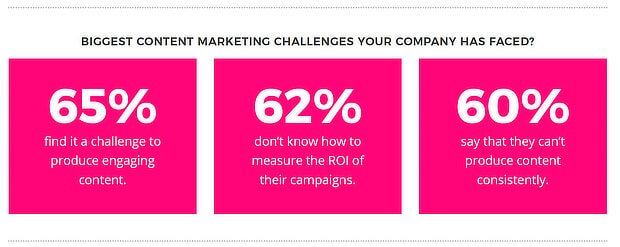
In most digital marketing strategies, blogging takes place on your own website. The blog usually exists as a separate web page, unless blogging is your business. However, some brands choose to build their authority and expertise with guest blogs, which are blogs published on third-party websites. These blogs include your name in the by-line and can help you get in front of new audiences and drive traffic to your website.
Guest blogging can also be used as a link building strategy. When you publish blogs on high-authority sites and include links to your own sites or content, your content gets an automatic boost by search engine algorithms. You look more like an expert by association, plus those links can drive traffic back to your own content.
You can also use external platforms like LinkedIn or Medium to build your blog. LinkedIn’s blogging platform is an excellent way to support a LinkedIn social media strategy. You’re publishing content for that specific audience, and users can like, share, and comment directly on your blogs.
I cover a lot of best practices, how-to’s, and other helpful guides on blogging on my own blog, which you can access here.
Email Marketing
Long live the inbox! When it comes to ROI, email marketing is about as effective as you’ll find. Studies show that email marketing can generate as much as a 4400% ROI for every dollar spent.
However, other reports peg the median number at closer to 122% ROI. That’s still four times more than any other digital marketing channel!
Email marketing can be leveraged in a number of ways. Many small businesses use it as a tool to talk about promotions and sales to increase revenue. You can also use it to drive brand awareness and stay top of mind with your audience.
If you’re blogging, you can use email marketing to promote your newest blog posts and drive more traffic to your website.
If your prospects have signed up for something with you (e.g. a free download, webinar, or e-book) but have not made a purchase, you can use email marketing to nurture your leads and increase sales conversions. This allows you to continue the conversation with people who weren’t ready to commit, so you miss out on fewer opportunities.
But don’t worry, you aren’t expected to send out each email yourself. I mentioned Hubspot above for their social media scheduling capabilities, but they also have a great email marketing tool. And what’s more — their email marketing tool is free. Check out their full platform here.
If you want the email capabilities of Hubspot but it’s not in the budget, I like to recommend Ontraport. Ontraport has tons of email marketing capabilities for a much more affordable price. Get your own free demo of Ontraport here.
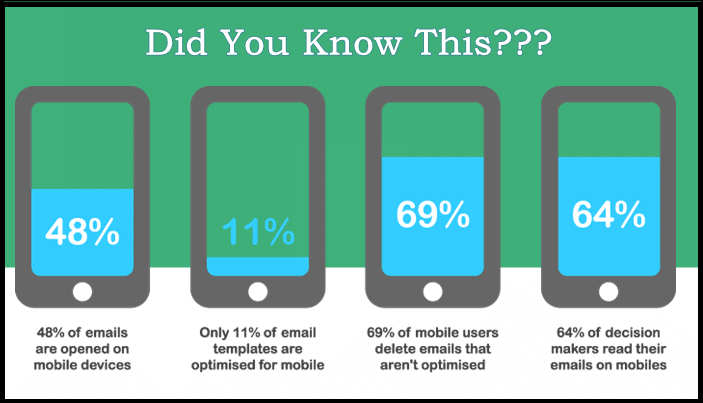
There’s a lot of value in email marketing above and beyond making sales. At the very least, your customers will keep you on their radar for the next time they need something you provide.
SEO
Last but not least, search engine optimization (or SEO) is a commonly sought-after digital marketing tactic that can have a major payoff in terms of online visibility.
SEO refers to a search engine’s ability to find your content and display it in relevant search results. This requires a unique way of creating and structuring your content so that it can be understood by algorithms AND appreciated by your human readers.
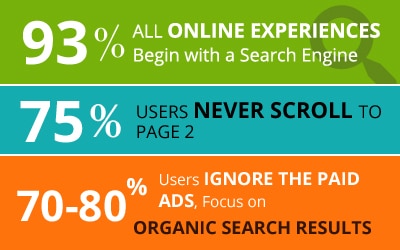
A lot of people are intrigued by SEO because they think it’s free marketing. But allow me to set the record straight: while you don’t pay a fee to show up in search, you DO pour time, money, and resources into creating and optimizing content that will be found in search. So it’s not technically free, but when done correctly, it can be a cheaper alternative to paid ads.
SEO contains a lot of moving parts, including keywords, link building, content formatting, meta data, images, mobile optimization, and user friendliness. You can learn SEO best practices on your own, but many entrepreneurs who are serious about SEO turn to an expert that can help them optimize their website, blogs, and landing pages. SEMRush also offers some SEO tools if you are looking for a more DIY approach — check out their “20 in 1” SEO tool here.
When you use SEO the right way and can rank high in search results, the content you created has no limits as to how much traffic or how many sales it can earn you. For example, if you spend $1,000 creating a how-to guide, but it’s well-optimized and earns you $10,000 over the next year just from search traffic, then it was well worth the time and money you spent creating it.
Other Things that Influence Your Digital Marketing Mix
Aside from your customer needs and preferences, you also need to take into account things like budget, expertise, and overall brand value. Sure, it might be nice to pursue SEO as a marketing strategy, but SEO requires in-depth knowledge, and hiring an expert could set you back thousands of dollars each year with no guarantee you’ll see the right results.
You may also want to consider how your future plans and goals are supported by your marketing mix. SEO is one that can take months before you start seeing results. However, once you do start moving the needle, the payout can carry your business for the long haul. SEO builds value over time, and if it means helping customers find you organically rather than through paid advertising, then it could be well worth the initial investment.
Last but not least, consider what your competitors are doing in their marketing. If they’re getting customers through a particular channel, you may want to consider using those channels, too.
To Summarize
You don’t have to pursue every opportunity to market your business effectively. Being selective in your marketing mix allows you to get the most from those specific efforts. Consider your customer base, budget, competitors, and long-term goals when choosing marketing channels and activities to prioritize.
Chapter 9: Understanding the Buyer’s Journey
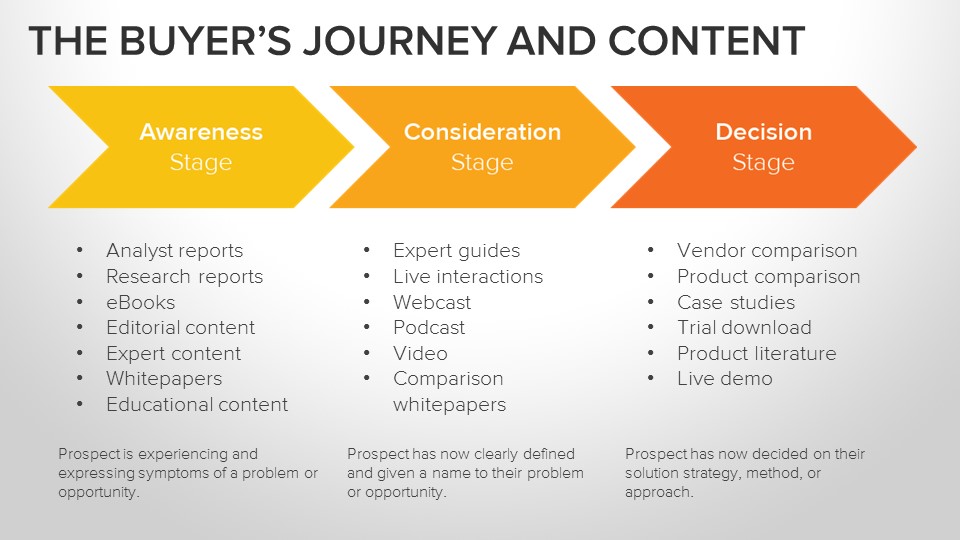
When you’re creating content for your digital marketing, something to keep in mind is where your buyer is in their decision-making journey. The content you create should speak to them at whatever stage they’re in to better cater to their needs at that time.
The buyer’s journey can be broken down into four stages:
Awareness Stage
The Awareness stage is where your newcomers live. They’re not familiar with your company or brand, or what you might be able to do for them. Content designed for these buyers should focus on building credibility and trust, highlighting your brand more than your products and services, and talking about problems the buyer might have.
Types of content you’ll want to use here could be
- Educational blog posts
- Explainer videos
- Slide decks
- eBooks
- Infographics
- Industry reports
Consideration Stage
In the consideration stage, buyers are more aware of your company and what you do. Once you’ve helped them recognize a problem, you can start to talk about ways to solve that problem. You’re bringing products and services into the conversation and heavily focused on educating your users.
Types of content you’ll want to use here include
- Technical articles
- Comparisons or white papers
- Webinars
- Product feature videos
Decision Stage
Once your buyer is ready to take action on their problem, they’ll start to research their options, including yours. Your buyer might make a shortlist of potential vendors or providers to help them. At this point, your goal is to highlight why you’re the best choice.
Types of content to use in the decision making stage include
- Case studies
- Free trials or demos
- Pricing comparisons
- Live consultations
Retention Stage
The retention stage is often overlooked in the buyer’s journey, but know that your customer relationships don’t end once they make a sale. You should continue nurturing the relationship and keeping communication open. It costs five times less to market to an existing customer than to try to get a new one. Plus, you can continue to earn their business when you engage in retention marketing instead of leaving it to chance. Retention marketing might include
- Email marketing
- Discounts on additional products
- Loyalty programs
To Summarize
Each type of content you create for your digital marketing strategy should take into account where your buyer is in their journey. It’s not about generating immediate sales with every marketing campaign, but rather developing relationships over time that show why you’re the best choice.
Chapter 10: Choosing Your KPIs
Your marketing Key Performance Indicators, or KPIs, help you measure the success of your marketing. A lot of things happen on the surface when marketing your business, but KPIs help you dig down deeper to see where you’re really moving the needle.

How to Choose Your KPIS
When selecting your KPIs, I recommend focusing on three specific factors:
Use rates and growth instead of total numbers – this gives you a clearer picture of your progress in a given time.
Set a period of time to measure your results – KPIs should be measurable, and this requires a unit of time. You might have weekly, monthly, and yearly KPIs to track your progress and see how you’re performing.
Set realistic goals – be real with yourself when setting expectations for growth. Use your existing data to help you create realistic projections instead of relying on guesswork alone.
What KPIs Should I Measure?
Choosing KPIs ultimately depends on what else is in your digital marketing strategy. You can set specific goals and KPIs for each activity you’re doing to see how it’s impacting your traffic, revenue, and bottom line.
For example, if you’ve made SEO a priority, then a KPI would be organic growth in a given time period.
If you’re marketing on social media, then some of your KPIs might include new followers, click-throughs, and conversion rates from social media channels.
In addition, you’ll want to include some general KPIs that can inform future marketing initiatives:
Cost Per Lead
Understanding how much you’re spending to get leads is essential to your company’s health. This cost includes advertising, as well as employee salaries (or your own salary if you’re a solopreneur). The goal is to get your cost per lead as low as possible. A high cost per lead and a low traffic to conversion ratio can signal danger.
Traffic to Lead Ratio
Not all website visitors will become leads, but the goal is to get as many visitors as possible to convert. The traffic to lead ratio tells you how many of those visitors become leads.
Customer Lifetime Value
Customer lifetime value refers to how much a customer spends with you over the course of their relationship with you. This is often considered a sales-related KPI, but marketing strategists can use it to determine how much profitability a customer has brought to the company. If a customer has a high total lifetime value, then marketers may want to try to get more leads from the same source.
To Summarize
Don’t waste time focusing on vanity metrics that make numbers look good but aren’t adding value to your business. Instead, choose KPIs that can be measured and illustrate just how much your business is growing.
Chapter 11: Reporting and Analyzing
There’s no doubt that tracking your progress is critical to your marketing success. Reports remove the guesswork from understanding how your marketing is performing and can give you deeper insights into what you’re doing well and what didn’t pay off in the way you’d hoped.
Once you’ve selected your marketing KPIs, reporting and analyzing becomes much easier. You already know what data to look for and can generate the reports that will show you what you want to know.
But where do you find your marketing analytics to review? This usually depends on what you’re doing to market your business.
Your Website
I would recommend starting with your own website’s backend. You should have an analytics dashboard that shows you website performance, along with the ability to dial deeper into specific metrics.
On your website analytics dashboard, you should be able to see important details like
- Number of visitors
- Average session duration
- Page views
- Most popular pages
- Purchases/Conversions
- Traffic Sources
- Bounce Rate
- Lead Gen Cost
- Value Per Visit
Each of these metrics can give you an idea of how well your website is performing and converting visitors into leads or customers. You should also review what content on your website is earning the most attention so you can create more of that type of content.
Google Analytics
You can install Google Analytics on your website to measure important performance metrics. This is a free tool that can track your entire sales funnel and dig into the metrics that matter most to you.
You can also use Google to measure the success of your paid ad campaigns through Google. Your Google Ads dashboard will track things like click through rate, ad quality score, conversion rate, cost per conversion, and ROI from your ads.
Facebook Analytics
If you’re using Facebook ads as part of your digital marketing strategy, you can use Facebook’s built-in analytics tools to learn more about your audience. Knowing where they’re located, their purchasing behaviors, your ad reach, and other details can help you improve your future Facebook ad campaigns to grow your success.
SEO Tools
If you’ve made SEO a goal, sophisticated tools like SEMRush can be invaluable to your reporting and analyzing process. Their tool can give you insight into the number of backlinks you’ve earned and where they’re coming from. It can also show you which keywords you’re ranking for, your position in organic search, and the difficulty of those keywords.
You can also use Moz to watch your Domain Authority score. Domain Authority is a metric created by Moz to show how much “weight” your website carries in terms of authority. Reputable and popular sites like New York Times and Facebook are going to have a high domain authority (on a scale of 1-100), while new websites or sites with low traffic will likely have single digit scores. The higher your Domain Authority, the more likely you are to rank well in search results. If you’ve made it a goal to increase your Domain Authority, Moz can show you your progress.
If you don’t want to invest in high-dollar SEO tools, Neil Patel’s UberSuggest tool offers several free features. It’s ideal for finding which keywords your site ranks for and how difficult it is to rank for those terms.
How to Analyze Your Marketing Metrics
When it’s time to analyze your marketing metrics, it’s easy to get lost in the number jumble. Ideally, you’ll have a list of questions that your metrics can answer, such as:
How much revenue did this campaign bring in?
- Where are my best referral sources?
- What’s bringing in (or not bringing in) website traffic?
- Where is the biggest drop off point in the customer journey?
- What do these successful or unsuccessful marketing activities have in common?
- What did I waste money on?
- Where did I lose or gain backlinks?
Once you have the what, you can start focusing on the why. For example, if you noticed your bounce rate decreased, you’ll want to try to figure out why it decreased. What were you doing differently that kept visitors on your site longer?
It’s also a good idea to record your metrics each time you analyze them so you can track your progress over time. Having real numbers to work with makes it easier to tweak your marketing strategy over time instead of starting from zero each time.
To Summarize
Reporting and analyzing your marketing activities gives you direct insight into what’s working and what’s not. Take time to track your progress so you can make the right adjustments to your strategy.
Chapter 12: Putting It All Together
We’ve covered a lot of high-level, in-depth information about putting together a complete digital marketing strategy. While you don’t necessarily have to do these steps in order, I find it’s helpful to take them one at a time in the order above so that you don’t overlook any critical components and can make the most of your efforts.
The last step is to put your digital marketing strategy into action. This means investing in the tools that will help you track and measure your progress, developing your buyer personas, tailoring your messaging, and creating content that will help you present your products in the right light.
And once you’ve embarked on your digital marketing strategy journey, I encourage you to review it at least once each year to see where you need to adjust. It’s okay if you don’t get it just right on your first attempt, and that’s often the reality for many solopreneurs and small businesses.
The goal is to keep trying until you find what works well for your business and customers, and then keep doing those things that will build brand presence, loyalty, sales, and strong relationships.
Disclosure: Please note that some of the links above are affiliate links. I only recommend products and services that I use and stand behind, and if you decide to try them, I will earn a commission at no cost to you. Doing so helps me provide free content to you, my readers.






2 Responses
Excellent Article. This really helped me with some ideas for marketing my own business!